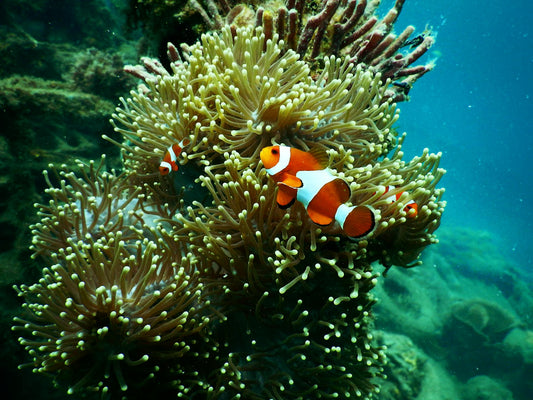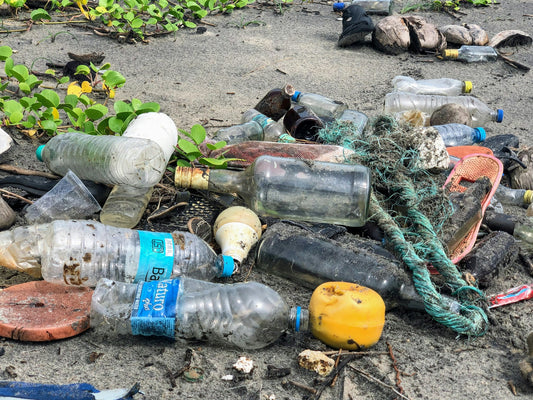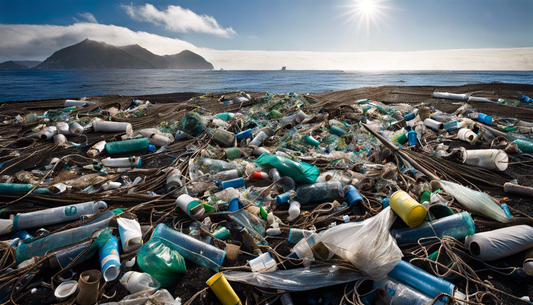Share
Squeeze, Brush, Rinse, Repeat
Think about a typical morning.
What is the first thing you do after your alarm goes off and you force yourself out of bed?

It is very likely that the answer is: You go into the bathroom and brush your teeth.
It is also very likely that you squeeze toothpaste out of a plastic tube and then rub microplastic against your teeth with a plastic toothbrush.
With plastic dominating every aspect of our lives, it is hard to keep track of how much all of these items contribute to pollution and impact our health.
In our new series "The Dirty Truth", we explore everyday items and the role they play in the big theme of pollution.
Today: Toothpaste & Toothpaste Tubes.
We'll shine a light on toothpaste numbers, production, and disposal, and in the end explore sustainable alternatives we can all use.
Toothpaste in Numbers
Around half of the worlds population or 3.6 billion people use toothpaste and they buy around 20 billion tubes every year.
With growing prosperity in developing markets, this number will grow in the coming years.
The global toothpaste market is set to grow steadily by 5% every year is expected to rise from $18.7 billion in 2023 to $25.7 billion in 2030.

Colgate-Palmolive holds around 40% market share of the toothpaste market and is expanding its power further every year.
But as Spiderman's Uncle Ben (and Voltaire) said: With great Power Comes Great Responsibility.
And while Colgate has finally introduced a recyclable toothpaste tube in 2023, it is unlikely that many of these tubes will really be accepted by recycling facilities.
Currently it is still safe to assume that an insignificant percentage of toothpaste tubes are recycled, while the vast majority end up on landfills (or nature).
With these numbers in the back pocket, let's understand the environmental impact of toothpaste production on our planet.
Toothpaste Production

To evaluate the environmental impact of toothpaste production, let us look at three components, the toothpaste, the tube & lid, and the carton
Toothpaste Ingredients
Typically, the toothpaste production process involves preparing five ingredients:
- Fluoride: Strengthens enamel, reducing cavities, nature's cavity fighter
- Abrasives: remove debris and stains, historically derived from shells
- Flavors: sweetening agents for taste without causing tooth decay
- Humectants: keep toothpaste moist, ensuring a smooth texture
- Detergents: create foamy texture, aiding in effective tooth cleaning
A liquid base is formed and then the other ingredients are mixed in steps by step until a smooth paste forms.
We could not find any information on the environmental impact of the actual toothpaste ingredients.
The main concern here is packaging. Especially the plastic tube that most toothpaste comes in.
Toothpaste Tubes
Plastic tube production is a resource intensive process.
Most toothpastes today come in plastic tubes made of polyethylene and polypropylene for bodies, and polypropylene for tops.
Both are plastics that rely on crude oil.
If we assume that a toothpaste tube needs around 1/4 of its volume in crude oil for production, a single 100 ml tube needs 25 ml of crude oil.
That may not sound like much, but if you add up the volume of 20 billion tubes worldwide, it leaves us with 500 million liters or 3.1 million barrels of oil needed for toothpaste tube production every year.
That is enough to drive 2.8 million miles or drive around the earth more than 111 thousand times.
Plastic tubes are made using so called extrusion or coextrusion processes. Plastic granules are melted and mixed in an extruder, then get shaped and cooled.
This process needs a lot of energy and produces carbon.
We know that the average plastic production emits 6 kg cabon for one kg of plastic. With an average weight of 30 grams per tube that brings us to 180 grams of carbon per tube.
Again, that's not a whole lot, but the quantity makes the difference. 20 billion tubes emitting 180 grams each adds up to 3.6 million tons of carbon per year.
Assuming 7.5 tons per household per year that is equivalent to the emissions of almost 500 thousand households.
And we're only accounting for production here. That does not include transport of the final product or its ingredients,
The Box

One of the dumbest things of our time (personal opinion) is that a toothpaste packed in a plastic tube comes double packed in a paper carton.
There is no reason for that carton other than supposedly making the toothpaste look better for the customer.
As a matter of fact, the first thing you'll do is throw it away immediately, as soon as you unpack the toothpaste - what a waste.
The EPA estimates that each ton of paper needs 17 trees.
If we assume that the average toothpaste box weighs 12 grams, 20 billion sold items every year bring us to 240 thousand tons of paper used.
This would leave us with 4 million trees cut down for a box that has no purpose.
Let's be generous and assume that 80% of the boxes are recycled paper, that would still leave us with 800 thousand trees.
Still seems out of line for that little box that is thrown away immediately after purchase.
And producing these 240 thousand tons of useless packaging create around the 225 thousand tons of carbon. That's around the same as 50 thousand cars.
Toothpaste Usage
The main ingredients in toothpaste are considered harmless.
But there are ingredients to look out for, which have been linked to serious health effects and pollution.
- Triclosan: Faces FDA scrutiny for potential hormone impact and leading to antibiotic resistance.
- Sodium Lauryl Sulfate (SLS): May irritate and contribute to mouth sores, with its byproduct, 1,4 dioxane, linked to organ damage.
- Propylene Glycol: Can cause organ damage in large quantities, leading to toxicity.
- Artificial Sweeteners: Linked to cancer and suggest harm to the gut biome's insulin response.
- Titanium Oxide: Used for whitening. Banned in the EU due to mouse genetic damage.
- Parabens: Common in toothpaste, parabens mimic estrogen, potentially linked to breast cancer.
- Polysorbate 80: emulsifier to improve the texture and stability. Linked to inflammation and affecting the gut microbiota.
- Carbomer: Synthetic polymers primarily used as thickening agents. Generally safe to use but linked to skin irritation or allergic reactions.
It may surprise you that Polysorbate 80 and Carbomer are actually considered liquid microplastics.
After banning microbeads in cosmetics in many countries, liquid microplastics have occurred as a new threat.
Read more in our deep-dive about microplastics in cosmetics here.
Additionally, In many countries like India you can still find an abundance of toothpastes containing microbeads - tiny plastic particles that are added for abrasion.
As a result, these solid or liquid microplastics end up in the drain AND your body. Needless to say, they do not belong there!
Toothpaste Disposal

As with many of the items covered by our "The Dirty Truth" series, the biggest impact of toothpaste comes after throwing out the plastic tube.
in 2022 Colgate and Tom's made big announcements that their toothpaste tubes are finally recyclable. While it is certainly a great ambition and they've probably spent some time on the research for this, there is an important distinction to make here.
"Recyclable" does NOT mean "Recycled".
There are actually a number of lawsuits underway that expose this claim as greenwashing, because recycling facilities in North America don't accept the tubes as recycling. That means although the tubes are now made from HDPE (#2 plastic), they are not recycled in practice.
And even if they were, Recycling rates are not promising enough to deal with the flood of plastic waste.
HDPE is one of the most recycled plastics and it comes to average recycling rates of only 30% in the U.S..
That means even if we're super generous and assume that all toothpaste tubes are recyclable and 30% actually get recycled, we still have 14 billion tubes send to the landfill.
There, they take up to 500 years to break down and release significant microplastics into the environment.
Even worse, many of the toothpaste tubes end up in nature through littering or mismanaged waste, leaving a big chance to end up as one of the 10 million tons of plastic dumped into our oceans every year.
Eco-Friendly and Healthier Alternatives

Toothpaste tubes have a terrible impact on the environment and we will not recycle our way out of this. Only significantly reducing the plastic we use will save our planet in the long run.
Luckily, eco friendly alternative has been gaining more and more traction and people love it....Toothpaste Tablets!
They come in a biodegradable pouch or a handy aluminum travel box and are as refreshing as toothpaste can get.
With many options around Fluoride, taste, and container, everyone finds their eco-friendly toothpaste match!
Make the eco-friendly switch now and we can assure you: Once you go tab, you never go back.
We hope you enjoyed this article. If you want to read more like this, make sure to check out our Blog and follow us on Instagram. If you are interested in truly sustainable products, check out our Shop.
If you want to engage in the discussion, feel free to leave a comment below.








